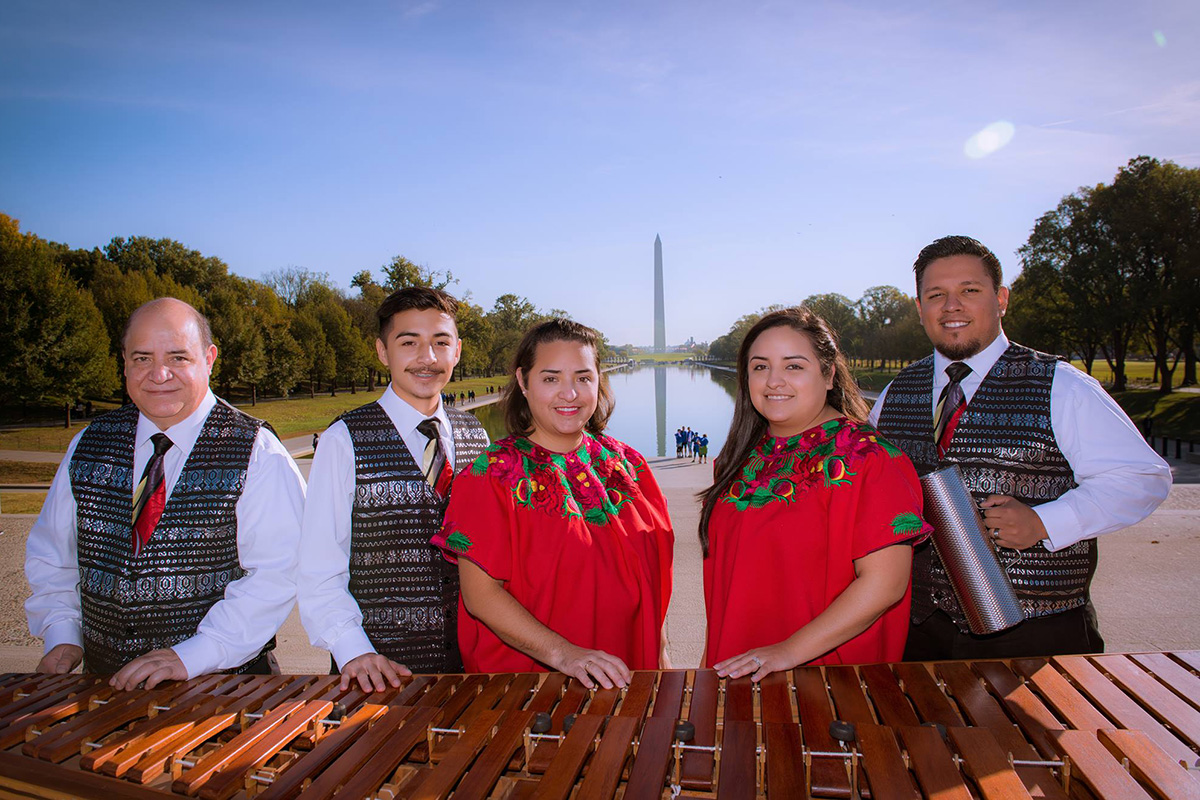Dancing to the rhythms of cumbia, students from various schools throughout the Archdiocese of Washington were reunited on March 20, 2019, through pupusas and the sounds of a Guatemalan marimba. Following a service at the Shrine of the Sacred Heart dedicated to the Salvadoran Saint Oscar Arnulfo Romero, the Maryland-based group Marimba Linda Xelajú brought lively music to the reception. This event for the Central American community of the Washington, D.C., area is one of the many settings where the marimba of this Guatemalan family group resonates.
A few weeks after this event, I met Robert Girón—who founded the group in 1996—and two of his children, Beverly and Junior. Robert is from Quetzaltenango in southern Guatemala, a city also known by its Mayan name, Xelajú. Although Robert had watched some of his family members play the instrument in Guatemala, it wasn’t until he arrived in the United States that a sense of nostalgia took over. He purchased a marimba so that he could learn how to play the songs of his homeland. With the support of his mother, Anselma León de Girón, the family brought a marimba built by Nojobel Salazar, a marimba maker also from Quetzaltenango, to their new home in Maryland.
Today, Robert and his children, Beverly, Jennifer, and Junior—as well as Beverly’s husband, Jeffrey Bonilla, plus bassist Don Mauricio Gutiérrez and drummer Walter Sánchez—form Marimba Linda Xelajú (“beautiful Xelajú”). Besides its reference to Quetzaltenango, the name of the group also refers to the popular song “Luna de Xelajú” (“Moon of Xelajú”) composed by Paco Pérez. This song is very popular in Guatemala, to the point where some people believe it is Guatemala’s second anthem. In addition to folk and traditional Guatemalan songs, the family performs popular music including cumbias, boleros, and jazz. They even learned “New York, New York” from a Guatemalan maestro.
“I remember that my parents would make us study the marimba during the summer,” Beverly recalled of their childhood. “That really helped us to grow and be music professionals—not to play it as a hobby, but as a career.”
“Practice was normal for us,” Junior remembered. “It was something that we thought everyone else did when we were children. But then I would go to school and they would ask me, ‘What did you do this weekend?’ and then I would say, ‘I had marimba practice.’ ‘What is that?’”
Beverly and Junior were born and raised in the United States, but they recently traveled to Guatemala, where they played the marimba in various settings. Beverly got to perform at the National Theater.
“I remember that my grandpa was there,” Beverly described. “He cried because I was the only girl among all the men. So, it was something… powerful. It was empowering, to experience that feeling.”
Junior played marimba—quite unexpectedly—in a restaurant.
“It was a proud moment: just going to the restaurant, seeing a marimba there, and being confident enough in my motherland to ask to play, and play. It was nice.”


During our conversation in their house, Robert explained the personal significance of the music.
“We formed a family where the musical instrument unites us, the marimba. Even though we are far from our country, we represent Guatemala.”
The marimba is often thought of as an instrument of African heritage, but in Central America it is now mostly associated with indigenous and Ladino (mixed indigenous and Spanish) peoples. Junior gave me a short marimba lesson and explained its structure. This percussion instrument, which is played by multiple musicians simultaneously, consists of four main sections: piccolo, tiple, armonía, and bajo, from highest to lowest pitched. Because the performers strive for a dense, buzzing sound, they strike the middle of the wooden keys with the rubber mallets to produce a resonant sound.
The Girón family also founded the Hermandad del Señor de Esquipulas, a Catholic community organization in Silver Spring, Maryland, that honors the Black Christ of Esquipulas—a miraculous wooden figure celebrated by Central Americans on January 15. In a similar manner to their marimba, the family brought a Black Christ of Esquipulas from Guatemala with the help of Robert’s wife, Letty.
In January, the family gathers with other Central Americans in Silver Spring. Like other aspects of their lives, the marimba is an important element of the celebration. In this case, the instrument accompanies the mass that honors the Black Christ. During the entrance, they play “El Señor de Esquipulas” and sing.
Crafted in 1594 by a Portuguese sculptor named Quirio Cataño, the wooden figure of Christ was delivered to the parish of Esquipulas in eastern Guatemala, near Honduras and El Salvador, in 1595. Over the centuries, the figure blackened because of the soot from the candles, and it has evolved to become an emblem of ethnic diversity in Central America. Today the Black Christ is celebrated in various parts of the United States, where Central American communities continue growing, such as Los Angeles, New Jersey, and Maryland.
Bringing the family together, the Guatemalan marimba continues to resonate in the D.C. metropolitan area, including the celebrations for the Black Christ of Esquipulas. Now, Robert Girón’s granddaughters, eight-year-old Isabella and seven-year-old Sophie, are taking their first steps as marimba players—even accompanying the group on the maracas.
Mariángel Villalobos is a PhD student in ethnomusicology at the University of Maryland. Besides her work with the Smithsonian’s Mother Tongue Film Festival this summer, she is conducting fieldwork among the Central American community in the D.C. metropolitan area. She is from San José, Costa Rica. This interview was translated from Spanish and edited for clarity.
Further Reading
Scruggs, T.M. 1999. “Central America: Marimba and Other Musics of Guatemala and Nicaragua.” In Music in Latin American Culture: Regional Traditions, ed. John M. Schechter, 80-125. New York: Schirmer Books.
Sullivan-Gonzalez, Douglass. 2016. The Black Christ of Esquipulas: Religion and Identity in Guatemala. Lincoln: University of Nebraska Press.


